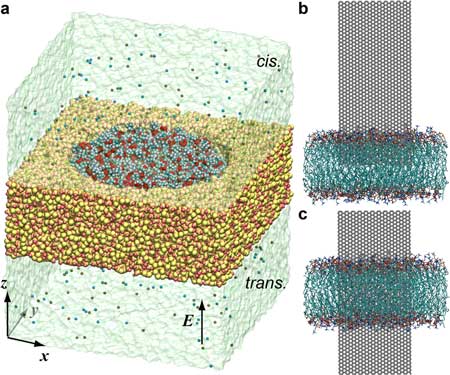| Posted: Feb 14, 2018 | |
Synthetic nanopores detect interactions between nanomaterials and cell membranes(Nanowerk News) Writing in ACS Nano ("Detecting Interactions between Nanomaterials and Cell Membranes by Synthetic Nanopores"), researchers propose proposed a low-cost yet efficient in vitro method to assess the nanotoxicity of nanomaterials toward the cell membrane. |
|
| According to the researchers, by measuring the ionic currents through a cell membrane supported in a solid-state nanopore, it is possible to detect the adverse particle-membrane interactions in real time. | |
| Generally, by measuring both DC and AC currents, phenomena such as particle adsorption, membrane thinning, and hole formation can be directly inferred. | |
| In this work, the team demonstrates that once a graphene nanosheet extracted about 17% of the lipids in the membrane and allowed water to penetrate into the membrane, a hole can occur on the membrane, accompanied by an increase in measured ion currents. | |
 |
|
| Setup of molecular dynamics (MD) simulations. (a) The nanopore system; Si and O atoms in the solid-state nanopore are shown in yellow and red; the POPC lipids filling the nanopore are shown as van der Waals spheres; K+ and Cl- are represented as tan and cyan dots; water is shown transparently. (b) A graphene nanosheet enters halfway through the membrane (Sim-1). (c) A graphene nanosheet enters the membrane entirely and is “symmetrically docked” on the membrane with equally exposed segments on both sides of the membrane (Sim-2). (© American Chemical Society) | |
| The simulation system for nanopore-based assessments of potential nanotoxicity of nanomaterials toward a cell membrane is illustrated above. Briefly, to obtain the SiO2 nanopore in silico, atoms in the solid membrane were fully mixed at a high temperature before being quenched to 300 K. During the quenching process, atoms within 5 nm of the z axis were harmonically pushed out, forming a cylindrical channel. Finally, the system was equilibrated at 1 bar and 300 K, with the periodic boundary condition applied in the x- and y-directions only. The thickness of the equilibrated membrane is about 5 nm. | |
| Analyzing the energetics and nanomechanics during the membrane burst and the hole formation processes revealed the important role of water. Other mechanisms of pore formation can be dependent on surface properties of a nanomaterial, such as the curvature, polarity, and roughness. | |
| Besides detecting toxicity of a nanomaterial, the nanosheet can be used to screen designed chemical modifications of an engineered nanomaterial and determine the most biocompatible one. | |
| Additionally, the efficiency of antimicrobial peptides/polymers can be conveniently tested and optimized toward bacterial membranes under certain conditions. | |
| "Broadly defined, nanomaterials/nanoparticles are not restricted to the engineered ones but can also include protein toxins, bacteria, or viruses that bind the cell membrane as the precursor of their invasion," the authors conclude. "Therefore, the nanopore platform described here provides a simple yet powerful means to study broad particle-membrane interactions in general." |
 By
Michael
Berger
– Michael is author of three books by the Royal Society of Chemistry:
Nano-Society: Pushing the Boundaries of Technology,
Nanotechnology: The Future is Tiny, and
Nanoengineering: The Skills and Tools Making Technology Invisible
Copyright ©
Nanowerk LLC
By
Michael
Berger
– Michael is author of three books by the Royal Society of Chemistry:
Nano-Society: Pushing the Boundaries of Technology,
Nanotechnology: The Future is Tiny, and
Nanoengineering: The Skills and Tools Making Technology Invisible
Copyright ©
Nanowerk LLC
|
|
|
Subscribe to a free copy of one of our daily Nanowerk Newsletter Email Digests with a compilation of all of the day's news. |
